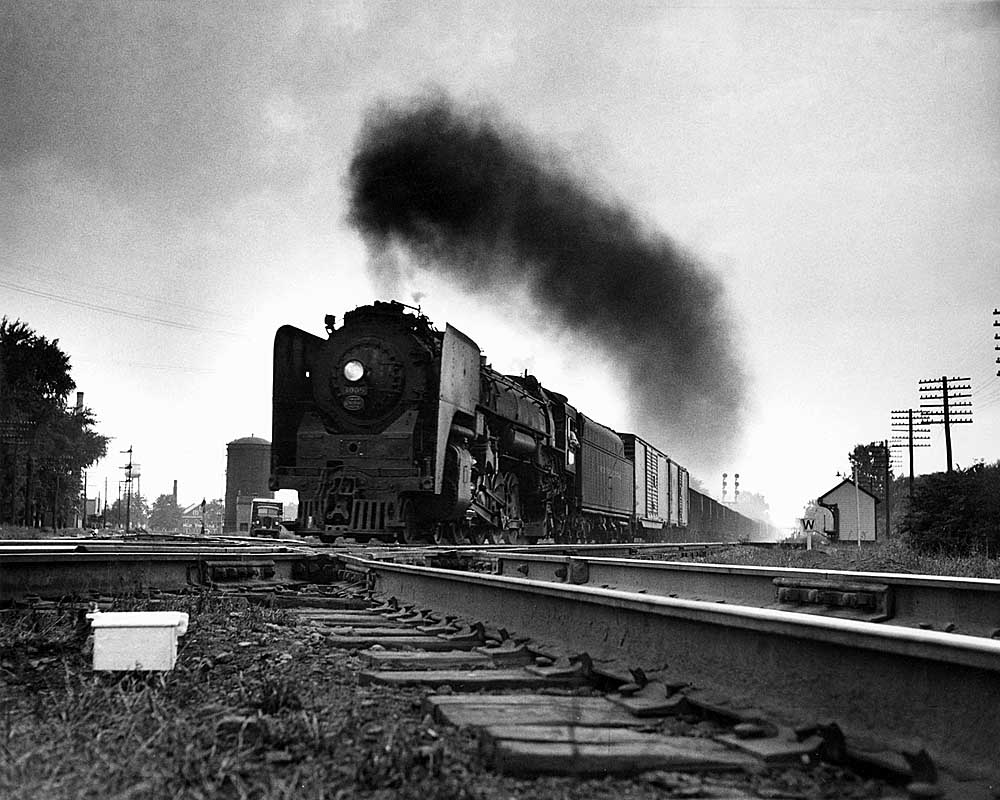
The photo is at once ordinary and extraordinary. Ordinary because the photographer had to grab it on the fly, shooting a low-angle wedge shot in low light as a New York Central steam locomotive snuck up on him out of nowhere. The photo is a bit dark and shows little of its creator’s compositional genius.
But the image is also extraordinary, thanks to the story his traveling companion attached to the photo and the fame it subsequently earned. It has come to be a favorite of legions of steam fans, including me.
The photo, of course, is Philip R. Hastings’ stirring portrait of NYC 4-8-2 No. 3005, a battered old Mohawk bearing down on the Central’s junction with the Baltimore & Ohio in quiet little Shelby, Ohio, in September 1955. Framed during Hastings’ famous series of 1950s steam safaris with Trains Editor David P. Morgan, 20 years later the Shelby incident became a capstone of the monumental Kalmbach book “The Mohawk That Refused to Abdicate, and Other Tales.”
Perhaps surprising to those who purchased the book back in 1975, Phil’s action shot didn’t make it onto the cover, at least in traditional halftone. Instead, his picture was transmogrified into an unusual graphic, framed by a red-and-silver arch, printed on foil paper, the big Mohawk rendered in sharp black ink by the book’s designer, the late Lawrence O. Luser. It’s time Larry had some props thrown his way.
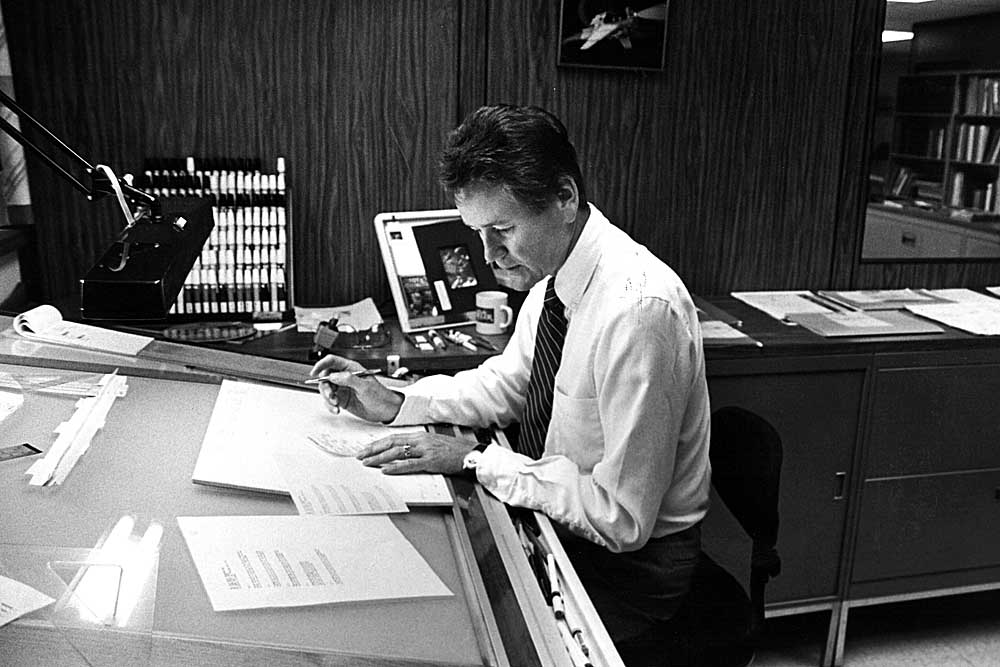
Larry Luser (pronounced “Lusser”) was a key member of the Kalmbach art staff in the 1970s, generally in charge of designing all the company’s how-to hobby books but also occasionally getting a plum assignment on a hardcover railroad book.
The “Mohawk” book was a heck of a plum. Filled with Hastings’ evocative photographs and Morgan’s blocks of fragrant prose, the book gave Larry a chance to stretch out, creating one of Kalmbach’s few truly deluxe coffee-table art books. It was blessed with Larry’s imaginative use of images, type, and white space and backed up by expensive duotone-black printing, a luxury secured from management by Books Editor Harold A. Edmonson.
The cover was a special challenge. Back then — and to some extent still today — railroad book publishers tended to put color paintings on the cover, regardless of the content inside. But color artwork would be ridiculous on a book featuring some of the greatest black-and-white railroad photography ever made. Together with Michael Stephens, a pal in the Sales Department, I rather timidly suggested the cover feature one of Hastings’ photographs, done up in duotone on heavier paper. But no one was listening to a couple of rookies from Sales.
Instead, Larry went with the approach we all came to know as the “Mohawk” cover, spotlighting his drawing of the 3005 and done up in disco-era typography that can only be described as deeply Seventies. If you have a copy, you’ve likely noticed the foil dust jacket doesn’t stand up well to the scuffing it gets on a bookshelf. If nothing else, though, Larry’s design was singular and memorable.
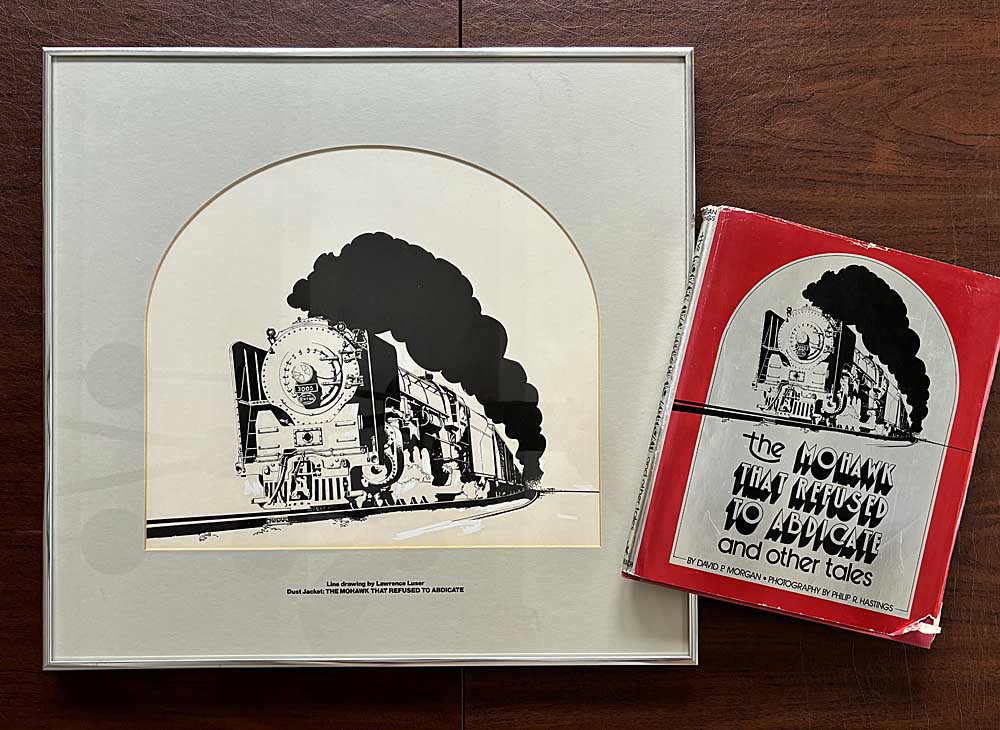
As Kalmbach’s ad copywriter, I had a role in the “Mohawk” project, overseeing the creation of direct-mail promos and magazine ads. Luckily, Larry was my partner, doing double duty as both book and promotions designer. He was easy to work with: quiet, unassuming to a fault, but very sure of what he wanted to do.
Among all the people working in Kalmbach’s Art Department, Larry was closest to Milwaukee’s fertile advertising and graphic arts community. He had studied at the city’s famous Layton School of Art, and, in terms of what was happening in graphic design in 1975, was closer to the cutting edge than his co-workers. I believe he saw “Mohawk” as a showcase for his peers.
For all the praise the “Mohawk” book has attracted over the years —in steam circles it’s discussed in hushed admiration — I’m not sure it sold all that well. Unlike several other Kalmbach titles (“The Hiawatha Story” or “The Nickel Plate Story,” for instance), “Mohawk” never got a second printing as near as I can tell, which is amazing, given the book’s hold on readers’ imaginations nearly five decades later.
I’ll always think of “Mohawk” as Larry’s book as much as Hastings’ or Morgan’s. I hope he took a lot of pride in it. He’d go on to other good things, including winning Folio magazine’s Ozzie Award for Design Excellence for his work on the short-lived Trains Illustrated, for which I served as an associate editor. Sadly, he died way too young: Sept. 12, 2004, at age 63, having retired from Kalmbach in 2000 after 38 years with the company.
Postscript: One day about 15 years ago, Kalmbach’s corporate art director, Maureen Schimmel, called me to say I needed to look at some stuff hidden away in a storage room at the back of our building. The Art Department was getting rid of things it didn’t need any more. One of them was Larry’s original drawing of NYC 3005.
“Are you kidding me?!” I said to Maureen, astonished over the sacrilege. “You can’t throw this away!”
Then she said the magic words. “You want it? You can have it.” So it was that Larry’s “Mohawk” artwork ended up in my car that afternoon. It’s been part of my modest collection ever since. And now it’s moving on to an even better place: the Center for Railroad Photography & Art, recent recipient of the corporate railroad art of the late, great Kalmbach Publishing Co.






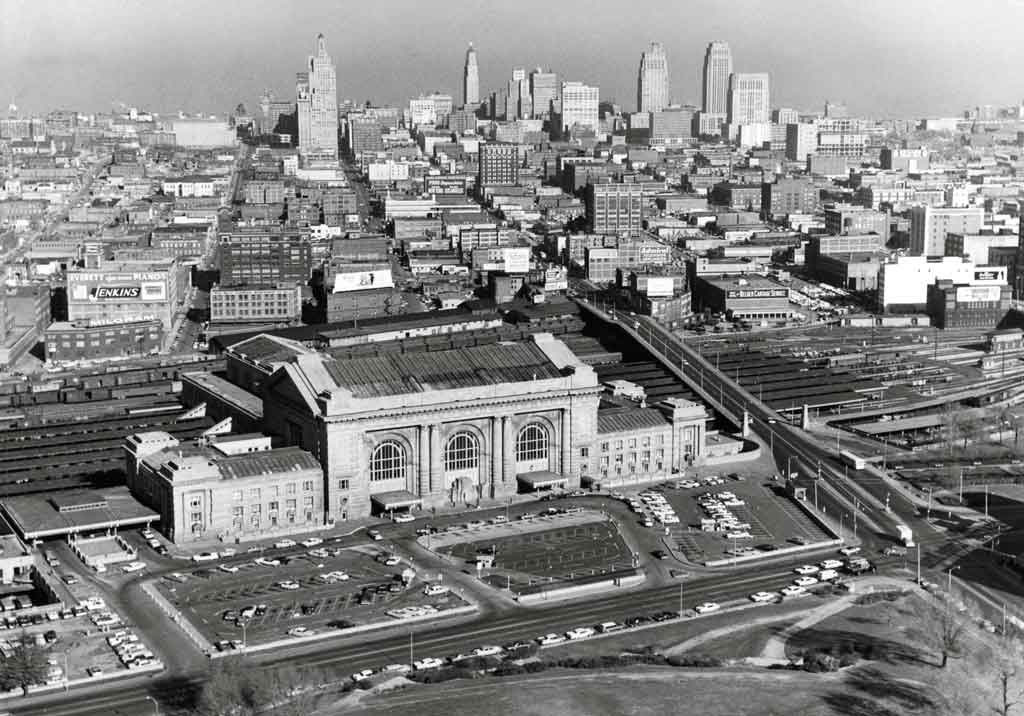


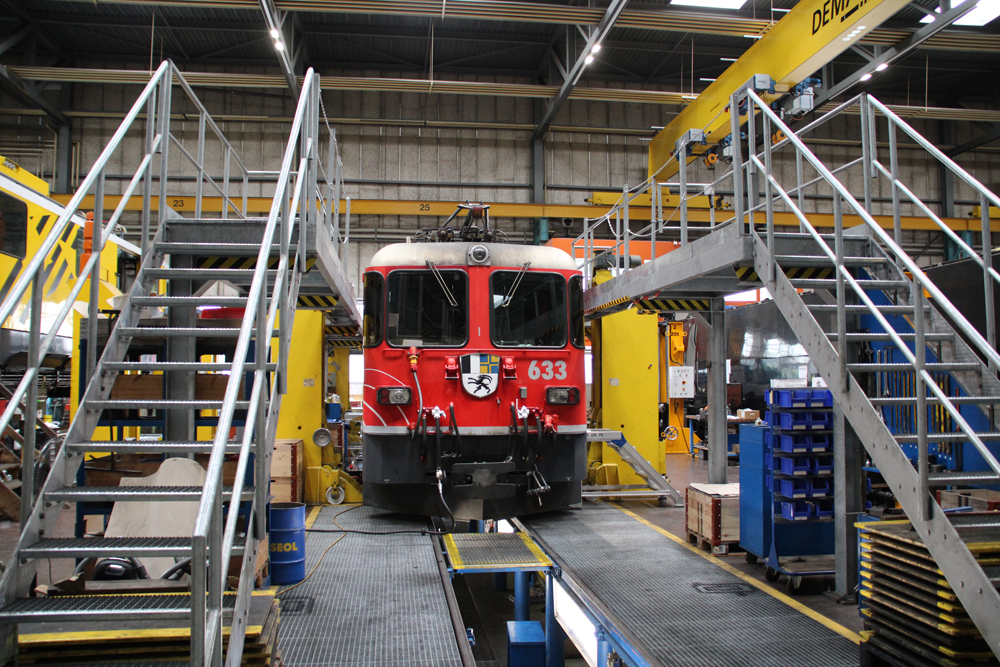




Mohawk was one of the first railroad books I could afford to purchase way back when… Where my library is much larger today Mohawk has a special place in my collection. Great to know the history behind the cover. Thanks Kevin for sharing it with us.
I enjoyed the story about the “Mohawk” book cover is enjoyable. I never had the book, but I remember discovering Hastings’ photo accompanied by the prose written by the inimitable David P. Morgan. Published in Trains in September 1956, I first saw this as a teen two decades later.
The article was part of the 14-part series “Steam in Indian Summer” that chronicled the quest of Morgan and Hastings to witness and capture, in film and in words, the swan song of steam. Without question, the scene painted by Morgan and Hastings is, in my opinion, a candidate for the best reading ever to grace the pages of Trains magazine. The story describes New York Central 4-8-2 No. 3005, relegated by dieselization to hauling a dead freight on a September afternoon nearly 70 years ago.
The description is of a battered old steam engine in its final days, and to the observers’ skepticism about the 3005 can pull its train at speed. Morgan and Hastings moved on ahead of the dead freight, were soon to be surprised by the 3005’s performance as they watched the scene from the tower in Shelby, Ohio.
“Why, it’s the extra! Can’t be … it is and he’s rolling!
“Rolling is mild language for what he was doing. Extra 3005 East, now no less than 98 cars between tank and caboose, was bearing down on Shelby with all the implications of destiny of the Book of Revelations, gaining momentum with each revolution of those four pairs of 69-inch drivers, making the legal mile a minute with ease and perhaps a notch or two better. The elephant-eared aristocrat of an Alco rammed across the diamond with smoke going high, the Baker up near center, and the crew enjoying the breeze. Out of her dusty wake came her train rattling, rocking, rolling, riding to Cleveland at such a pace that, as Hastings recalls it, “one felt called upon to wonder at what moment the whole shebang would take either to the air or to the adjacent countryside.”